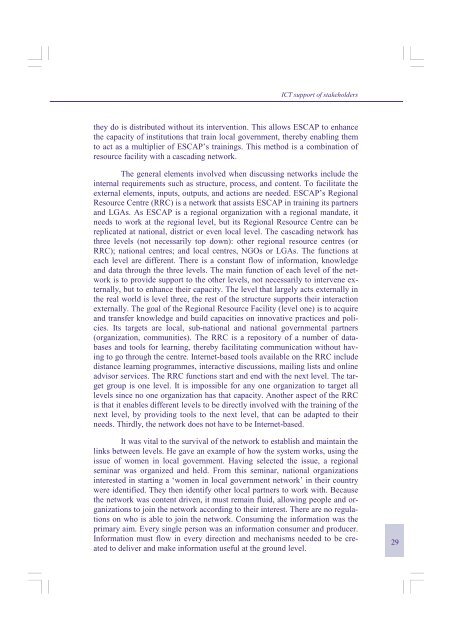Report of the Regional Workshop - Escap
Report of the Regional Workshop - Escap
Report of the Regional Workshop - Escap
Create successful ePaper yourself
Turn your PDF publications into a flip-book with our unique Google optimized e-Paper software.
ICT support <strong>of</strong> stakeholders<br />
<strong>the</strong>y do is distributed without its intervention. This allows ESCAP to enhance<br />
<strong>the</strong> capacity <strong>of</strong> institutions that train local government, <strong>the</strong>reby enabling <strong>the</strong>m<br />
to act as a multiplier <strong>of</strong> ESCAP’s trainings. This method is a combination <strong>of</strong><br />
resource facility with a cascading network.<br />
The general elements involved when discussing networks include <strong>the</strong><br />
internal requirements such as structure, process, and content. To facilitate <strong>the</strong><br />
external elements, inputs, outputs, and actions are needed. ESCAP’s <strong>Regional</strong><br />
Resource Centre (RRC) is a network that assists ESCAP in training its partners<br />
and LGAs. As ESCAP is a regional organization with a regional mandate, it<br />
needs to work at <strong>the</strong> regional level, but its <strong>Regional</strong> Resource Centre can be<br />
replicated at national, district or even local level. The cascading network has<br />
three levels (not necessarily top down): o<strong>the</strong>r regional resource centres (or<br />
RRC); national centres; and local centres, NGOs or LGAs. The functions at<br />
each level are different. There is a constant flow <strong>of</strong> information, knowledge<br />
and data through <strong>the</strong> three levels. The main function <strong>of</strong> each level <strong>of</strong> <strong>the</strong> network<br />
is to provide support to <strong>the</strong> o<strong>the</strong>r levels, not necessarily to intervene externally,<br />
but to enhance <strong>the</strong>ir capacity. The level that largely acts externally in<br />
<strong>the</strong> real world is level three, <strong>the</strong> rest <strong>of</strong> <strong>the</strong> structure supports <strong>the</strong>ir interaction<br />
externally. The goal <strong>of</strong> <strong>the</strong> <strong>Regional</strong> Resource Facility (level one) is to acquire<br />
and transfer knowledge and build capacities on innovative practices and policies.<br />
Its targets are local, sub-national and national governmental partners<br />
(organization, communities). The RRC is a repository <strong>of</strong> a number <strong>of</strong> databases<br />
and tools for learning, <strong>the</strong>reby facilitating communication without having<br />
to go through <strong>the</strong> centre. Internet-based tools available on <strong>the</strong> RRC include<br />
distance learning programmes, interactive discussions, mailing lists and online<br />
advisor services. The RRC functions start and end with <strong>the</strong> next level. The target<br />
group is one level. It is impossible for any one organization to target all<br />
levels since no one organization has that capacity. Ano<strong>the</strong>r aspect <strong>of</strong> <strong>the</strong> RRC<br />
is that it enables different levels to be directly involved with <strong>the</strong> training <strong>of</strong> <strong>the</strong><br />
next level, by providing tools to <strong>the</strong> next level, that can be adapted to <strong>the</strong>ir<br />
needs. Thirdly, <strong>the</strong> network does not have to be Internet-based.<br />
It was vital to <strong>the</strong> survival <strong>of</strong> <strong>the</strong> network to establish and maintain <strong>the</strong><br />
links between levels. He gave an example <strong>of</strong> how <strong>the</strong> system works, using <strong>the</strong><br />
issue <strong>of</strong> women in local government. Having selected <strong>the</strong> issue, a regional<br />
seminar was organized and held. From this seminar, national organizations<br />
interested in starting a ‘women in local government network’ in <strong>the</strong>ir country<br />
were identified. They <strong>the</strong>n identify o<strong>the</strong>r local partners to work with. Because<br />
<strong>the</strong> network was content driven, it must remain fluid, allowing people and organizations<br />
to join <strong>the</strong> network according to <strong>the</strong>ir interest. There are no regulations<br />
on who is able to join <strong>the</strong> network. Consuming <strong>the</strong> information was <strong>the</strong><br />
primary aim. Every single person was an information consumer and producer.<br />
Information must flow in every direction and mechanisms needed to be created<br />
to deliver and make information useful at <strong>the</strong> ground level.<br />
29

















